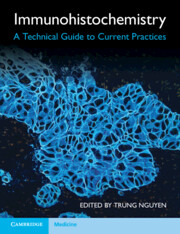Book contents
- Immunohistochemistry
- Immunohistochemistry
- Copyright page
- Dedication
- Contents
- Contributors
- Preface
- Chapter 1 Immunohistochemistry Fundamentals
- Chapter 2 Immunohistochemistry Quality Assurance and Quality Control
- Chapter 3 Automation and Robotics with the Leica Bond III
- Chapter 4 Automation and Robotics with the Roche Ventana BenchMark ULTRA
- Chapter 5 Automation and Robotics with the Agilent Dako Omnis
- Chapter 6 Immunohistochemistry for Research Applications
- Chapter 7 Troubleshooting Immunohistochemistry
- Chapter 8 Current Status of Immunohistochemistry
- Chapter 9 Immunohistochemistry for Future Applications
- Index
- References
Chapter 8 - Current Status of Immunohistochemistry
Published online by Cambridge University Press: 16 June 2022
- Immunohistochemistry
- Immunohistochemistry
- Copyright page
- Dedication
- Contents
- Contributors
- Preface
- Chapter 1 Immunohistochemistry Fundamentals
- Chapter 2 Immunohistochemistry Quality Assurance and Quality Control
- Chapter 3 Automation and Robotics with the Leica Bond III
- Chapter 4 Automation and Robotics with the Roche Ventana BenchMark ULTRA
- Chapter 5 Automation and Robotics with the Agilent Dako Omnis
- Chapter 6 Immunohistochemistry for Research Applications
- Chapter 7 Troubleshooting Immunohistochemistry
- Chapter 8 Current Status of Immunohistochemistry
- Chapter 9 Immunohistochemistry for Future Applications
- Index
- References
Summary
The current utilization of immunohistochemistry (IHC) in a diagnostic context is discussed. The modern facility requirements, the various roles IHC is tasked with and the key concept of standardization are covered. Common terminologies are addressed and explained within an IHC context. The terms 'validation' and 'verification' provide one example of words which may cause confusion. The present status in terms of protocol set-up, antibody clones and epitope retrieval are offered to emphasize current best practice. A treatise is given concerning IHC’s special relationship with emerging molecular technologies and how these two analytical devices are shaping diagnoses and treatment strategies for patients. Specific examples are taken from melanoma, breast, lung and bowel cancers. The reader should be able to ascertain the role of IHC in today’s pathology laboratories.
Keywords
- Type
- Chapter
- Information
- ImmunohistochemistryA Technical Guide to Current Practices, pp. 210 - 252Publisher: Cambridge University PressPrint publication year: 2022

